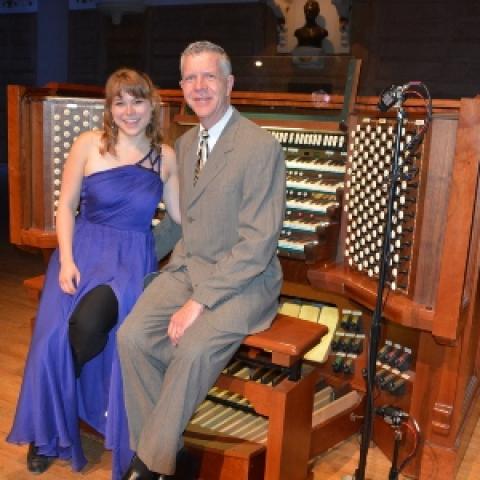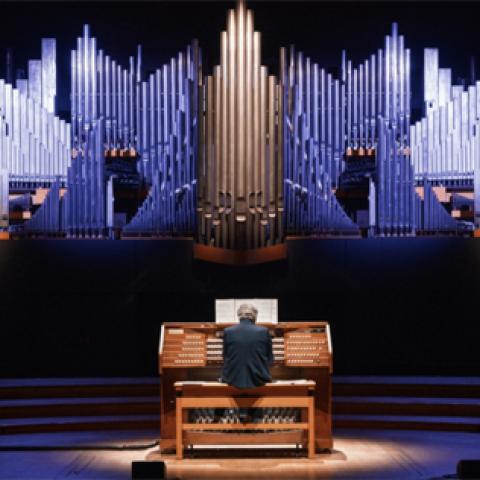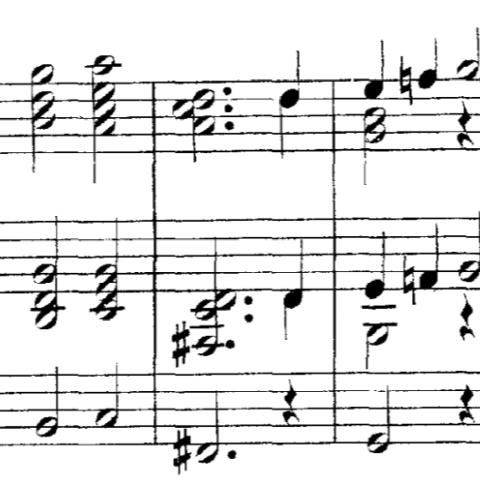Lorraine Brugh is professor of music and Kruse Organ Fellow at Valparaiso University, Valparaiso, Indiana. She recently served as director of the university’s study abroad program in Cambridge, England.

Prelude
Filled with sunshine and warm temperatures, June 17 in Lyon was a day Olivier Messiaen would certainly have approved. The cavernous dark room of the Church of Saint Pothin would have also certainly met with the master’s approval, its mosaic dome crowning the apse and the organ filling the entire east end of the nave.
The simple, modern organ case with dark red and brown wood, crowned with white and gold molding, did not give away what was inside. The organ was built by Joseph Merklin et Cie in 1876. It was completely renovated in 2004 by Daniel Kern Manufacture d’Orgues of Strasbourg. While Merklin built a two-manual instrument, it is now three manuals.
The resonance of Saint Pothin, with its two to three second reverberation, created an ideal aural space for the first round of the competition, which featured the works of Marcel Dupré and Olivier Messiaen. The ability to time an entrance following a rest or fermata became a distinguishing feature of the performers. Some were able to make the music just flow out of the reverberation; others were too eager to get on with the music.
More than fifty people gathered for this opening round of the competition. The usual motley crew of organists and enthusiasts, mostly over sixty, eagerly awaited the first candidate. A panel of nine judges, seven men and two women, held forth in front of the altar, conveniently blocking the console from view. The contestants sat in the nave, watching and listening to each other play. The six candidates, chosen from a field of seventeen applicants, were required to choose a prelude and fugue of Marcel Dupré and a piece of Messiaen. The contestants and their repertoire were:
Fanny Cousseau, France
Marcel Dupré, Prelude and Fugue in G Minor, opus 7, number 3
Olivier Messiaen, “Offrande et Alleluia final,” from Le Livre du Saint-Sacrement
Yanis Dubois, France
Marcel Dupré, Prelude and Fugue in F Minor, opus 7, number 2
Olivier Messiaen, “Dieu parmi nous,” from La Nativité
Charlotte Dumas, France
Marcel Dupré, Prelude and Fugue in G Minor, opus 7, number 3
Olivier Messiaen, “Alleluias sereins d’une âme qui désire le ciel,” from L’Ascension
Jacobus Gladziwa, Germany
Marcel Dupré, Prelude and Fugue in B Major, opus 7, number 1
Olivier Messiaen, “Alleluias sereins d’une âme qui désire le ciel,” from L’Ascension
Thomas Kientz, France
Olivier Messiaen “Dieu parmi nous”, from La Nativité
Marcel Dupré, Prelude and Fugue in G Minor, opus 7, number 3
Eszter Szedmák, Hungary
Olivier Messiaen, “Alleluias sereins d’une âme qui désire le ciel,” from L’Ascension
Marcel Dupré, Prelude and Fugue in G Minor, opus 7, number 3
The Olivier-Messiaen Competition, originally created in 1967 as a contemporary piano festival, was held in Paris until 2007. Now, in 2019, Bruno Messina, director of the Isère Agency for Artistic Dissemination (AIDA), is responsible for recreating it in the spirit allowed by the artistic project of Maison Messiaen, the artist’s residence in Matheysine. The Auditorium-Orchestre National de Lyon has become the home for this new international interpretation competition for the organ, under the chairmanship of Claude Samuel, founder of the Olivier-Messiaen Competition, former director of music at Radio France, and author of interview books with the composer.
The organ in the auditorium of Lyon was originally installed in Paris, built for the 1878 World’s Fair. It was situated in the large concert hall in the (former) Palais du Trocadéro and was the first Aristide Cavaillé-Coll organ to be installed in a French concert hall. The instrument was inaugurated with concerts in which Charles Marie Widor played the premiere of his Symphony No. 6 for Organ.
The organ was modernized and reassembled for the Exposition Internationale of 1937, part of the renovation of the Palais du Trocadéro into the Palais de Chaillot. Many works have had their premiere on this instrument, including Messiaen’s Les Corps Glorieux, performed by the composer himself on April 15, 1945.
The organ was moved and installed in Lyon in 1977 and most recently rebuilt in 2013 by Michel Gaillard, Manufacture Bernard Aubertin. The auditorium is today the only large organ room in France outside Paris.
The 2019 competition featured a newly commissioned work by Phillippe Hersant, a compulsory work in the competition’s final round. Mr. Hersant was present at the competition, serving as a jury member alongside several international Messiaen performers and scholars. Through the works of Hersant, Messiaen, and others, the competition offered a range of high level yet accessible organ literature to the audience. The competition was part of two weeks of programming that showcased the instrument for family outings, festive concerts, and high-profile recitals.
Olivier Latry served as president of the jury. On the day after the competition’s final round I asked him about his relationship to the competition’s revival. “I wasn’t involved in the planning of the competition from the beginning,” he explained:
"Others like Bruno Messina and Claude Samuel were central to transforming the event. I didn’t have to do anything with that; I was just asked to be president of the jury. The repertoire choices were also not mine, which was nice because it gave me new eyes and new ears. The planners eventually decided to make a competition for the organ, created out of the piano competition of twenty years ago. I think it’s more about the relation between Messiaen and the Trocadéro organ from the Palais du Chaillot that is the connection with Lyon than anything else. On that organ Messiaen played and dedicated some of his works when it was at the Palais du Chaillot. That connection as well has made a sort of comparison between the piano, the organ, and the competition."
Intermezzo
Where but in France could one walk into a laundromat at 8:30 in the morning and meet someone who had attended Thierry Escaich’s organ concert two nights before? As I struggled to figure out how to make the washer start, a French woman came to my aid and guided me through the complex maze on the wall to get soap and pay for the washer. As we waited interminably for our clothes to dry, we struck up a little conversation. Little was the only possibility as my French was un peu. I told her I was here for an organ festival, and she said she had just attended an organ recital two nights before. “Thierry Escaich,” I asked? “Oui, madame.” She and her husband are admirers and friends of Escaich and have known him for nearly thirty years. She told me Escaich was instrumental in the 2013 project to renovate the organ.
Her husband arrived and we chatted a bit more about the unusual duo concert we heard with Escaich and comédien Lambert Wilson. They said Wilson is one of the most celebrated actors in France, and what an honor it was for him to perform in Lyon. As the husband picked up the laundry bags, he said, “Well, we all have to get back to daily life sometime.”
Allegro assai
The second round of the competition moved to the auditorium, where the now five finalists each played a 20–25 minute program. This time there were two movements of a Bach trio sonata, a compulsory Messiaen piece from Livre d’Orgue, and a contemporary work. It was beginning to feel like a marathon to me, as fingers flew through the fast movements, carefully playing Messiaen’s many and intricate bird calls. The performers worked through their technically demanding literature quite deftly. At the conclusion of this round, four finalists were chosen to compete in the final round.
Final
The four finalists played again at the auditorium with a combination of compulsory and chosen works:
• In exitu Israel, a compulsory piece composed by Philippe Hersant, commissioned by the Olivier Messiaen Competition;
• a piece or pieces by Olivier Messiaen of eight to fifteen minutes in length chosen by the candidate; these pieces can have been played in the quarterfinal and semifinal rounds (the quarterfinal round by recording, the semifinal round at St. Pothin);
• a composition written between 1830 and 1945 chosen by the candidate.
This repertory must not have been played in a previous round.
Sortie
On the day following the finals, the competition was complete, and the judges presented an afternoon concert. As I had already left Lyon, I spoke with Olivier Latry by phone and asked about the results of the judges. The judges awarded no first prize. The second prize was awarded to Thomas Kientz, the third prize to Yanis Dubois, the Messaien prize to Fanny Cousseau, the audience prize presented to Eszter Szedmák, and the contemporary prize to Yanis Dubois. As to why there was no first prize, Latry explained, “I really must confess that some of my colleagues in the jury and I were disappointed in the playing in the final round, which was not as strong to me as the previous rounds. The performances were not at the level of an international competition. In order to continue the level of the competition, we need to raise the level of the first prize.”
I asked him about the rigor of the competition, its pressures, and the amount of literature required of the players. He responded, “I must say that it was not that strenuous, compared to Chartres or Montreal. It was normal. When we play literature for a concert tour it is normal for us to have three hours in our fingers, sometimes more. So the rounds were 1½ hours of playing. That is normal for someone who wants to make a career as a concert organist.”
In noting the importance of expressiveness in playing French literature, I asked how much the technicalities matter, for example, the micro-rhythms in Messiaen. Latry replied:
"With Messiaen, one cannot avoid the notes and the rhythms. This is the basis of his music. They are givens, and Messiaen is specific about that. It is important to follow those and not change them at that level. Then, when the notes and rhythms are correctly done, the performers can make their own interpretive decisions with things like registration, rubato, agogic, etc. But all of that should not interfere anymore with this first step; notes and rhythms have to be kept."
We closed the conversation with Latry musing about the importance of competitions. I found that he had some surprising comments:
"I’m not a great fan of competitions. Usually I refuse to adjudicate a competition. The difference this time was that it featured the music of Messiaen, for which I have a deep affection. Who am I to judge someone? Why would my judgment be better than someone else’s? How can I say that one player is better in music than another one? Unfortunately that is the only way for young musicians to become known.
"I think we need new ways for young musicians to be known. What can we do to create a venue for them? There are certain young players that we know, and many that we don’t. In fact I would like to imagine some kind of meeting (not called a competition) where we can invite ten to sixteen young players, and we all listen to them. Then, after their performances, we could organize some masterclasses on the pieces they played, telling them what we liked, what we didn’t, what could be improved, etc. Towards the end I might say, ‘I really love what they do,’ and I might relay that name to someone who would not know of this young player.
"The pressure created in that kind of meeting, even without being a competition, however, is very important. When we create a performance situation, the pressure is part of the whole situation. It needs to be part of the player’s strategy to handle it. On various occasions, for example, when I premiered a new organ/orchestra piece with the Philadelphia Symphony, there was incredible pressure. I think it’s the same kind of thing. I haven’t judged before, but I think it’s the same way. Any competition, or a jury exam for a doctoral degree even in other fields than music would require the same thing. I think it is part of the skill to be able, in spite of the stress of the performance, to go to another dimension in those situations. Most people stay at the level of the composition, ‘playing the notes,’ but they really need to go further. The jury members are looking for something ‘more.’ I’m speaking about that other dimension needed for a complete, successful, and touching performance."
I was taken by these words from one of the world’s greatest players. The combination of high expectation and a calling to give new young organists a venue to be heard impressed me. The combined need for heeding the composer’s intentions and adding one’s own expressiveness and interpretation calls for the highest level of musicianship. The fact that no first prize was awarded was evidence to me of the need for all of us who teach young organists to encourage and support, while, at the same time, keep the bar high for the next generation.





